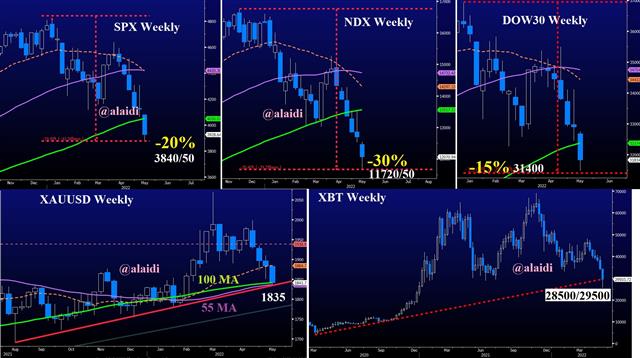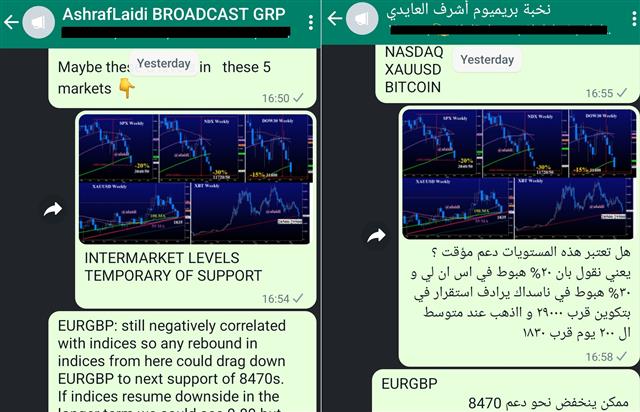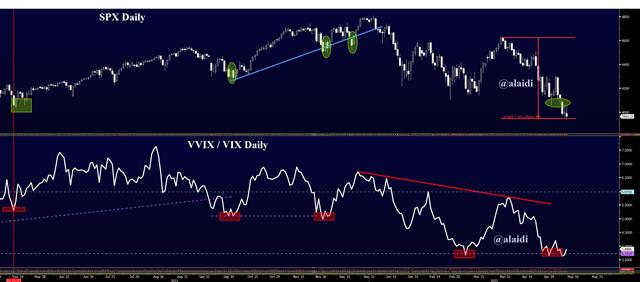Intraday Market Thoughts Archives
Displaying results for week of May 08, 20223850 11690 31220 and the rest


In Thursday's case, as S&P500 fell to 3928, I highlighted 3840/50 as the point of 20% decline from its highs, qualifying as bearish market territory. I added the 11720/50 level for Nasdaq100 as the -30% threshold and 31400 in the DOW30 as 15% downside from its highs. Identifying the levels in these 3 charts served as a warning—even as those levels had not yet been hit by the time of chart publication (Thursday 16:15 London Time).
Considering the correlation between cyptos and risk-assets, I highlighted the 28500-29000 range as the must hold level for Bitcoin (March 2020 trendline support on a closing basis), combined with other quantechicals, shared exclusively with the WBG.
Towards the end of Thursday's US session, markets sustained a fresh risk-off attack, forcing SPX, Nasdaq100 and Dow30 to new daily lows at 3858, 11690 and 31220 respectively. The levels were in line with the points highlighted in the charts as it was for Bitcoin. The sole exception was gold, which ended up breaking the $1830 trendline and is currently resting atop $1800.
As time of writing (Friday 18:50 London time), indices are up more than 3% for growth and 1.5% for value and are about to deliver the first Up-Friday session since March 25. The next challenge is where do we mark the top in this bear market rally? But this could all change if SPX manages this 100-WMA accomplishment stated here.
The term “intermarket analysis” is so widespread to the extent of often diluting the powerful benefits it brings to analysts and traders alike. 15 years ago this month, I began writing “Currency Trading and Intermarket Analysis” into the eventful summer of 2007 and completing it in (a more eventful) summer 2008. More on those 12 months in another post. The book had a currency angle, but could have been more effective if it showed how to combine intermarket dynamics with classical technical analysis. Over the last 10 years, I deepened my involvement in markets, studying and trading the cross-asset dynamics with key chart patterns. The above charts illustrate how it's put to use.From Flation to Stag & Back

The CPI pullback emerged largely from slowing energy prices and retreating prices of used autos. Since the former is expected to push back up due to rebounding gasoline prices, deflationistas will hope for an offset from prolonged declines in used autos.
The challenge ahead for traders is to figure out when markets shift their focus from inflation to recession. The simultaneous accelerating decline in bond yields and tech stocks (around 2 pm Eastern) may have been related to robust demand in the 10-yr auction, but keep an eye on the big picture. Read on…
Gold rebounded $25 from 1832, while bond yields resumed the week's decline alongside fresh selloff in stocks. Apple hit a new low for the year, Amazon broke its 6-year trendline and Netflix extended its losses to -75% from the highs. The stocks-bonds damage to “SuperPortfolios” is officially joining the damage to “WorkingClass” purchasing power to break consumer demand/growth and corrode that wealth effect.
Recession rumblings were amplified today after CPI went from 8.5% to 8.3%. Imagine what noise the “stag” part will do when “flation” goes from 8.3% to 8.0%...or below 8.0%. Let's not even look at the month-month figures.
Don't forget the yield curve metric. Many think we need to see another round of inversion to spell recession. Wrong. Any continued steepening from current levels will mean the doves are coming around. But if the 3-5 spread soon drops below zero from its current 0.06 and 2-10 nears 0.10 from 0.28, then it might take a bit longer.
Currency developments also bear watching. German-US 10 yr spread has continued to stabilize alongside EURUSD, and EURGBP is strengthening its negative correlation with risk assets. Then you have gold, which is fighting to hold above its 200-DMA and August trendline.
We're not sure what will come first: A sub 5.0% inflation print in the US, or an official recession declaration from the US NBER. But here's my latest call: By the time US CPI drops near 6%, we'd see a steeper yield curve, a more confident Fed (with its inflation-taming efforts) and weaker growth. Metals will get their next wave of vigour once markets realise consumer prices have settled at a higher low.







